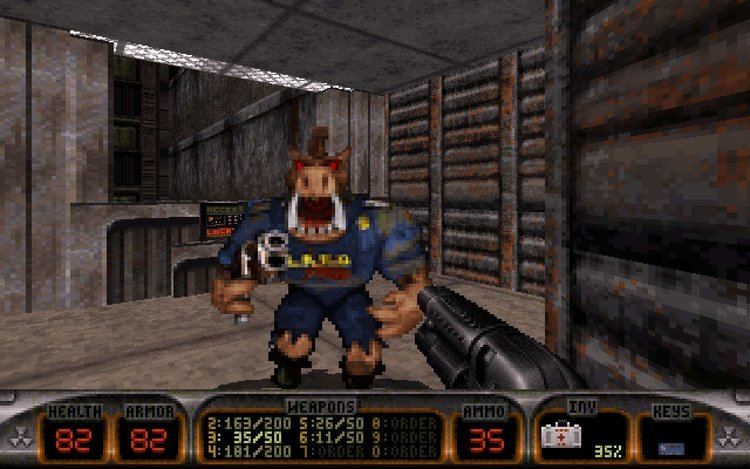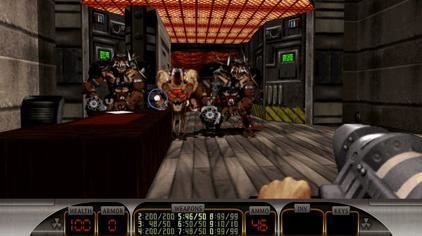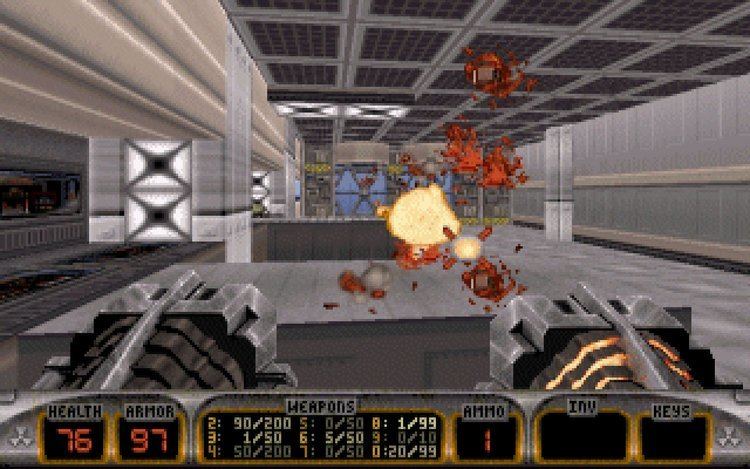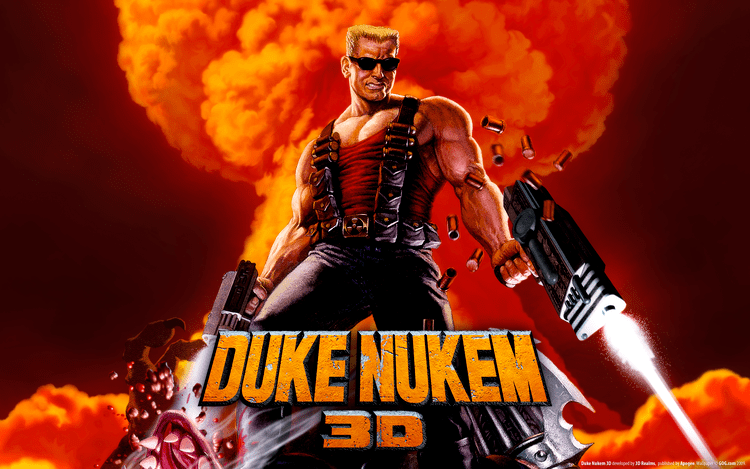9 /10 1 Votes
8.8/10 GameSpot Genre(s) First-person shooter | 9/10 Steam Initial release date 1996 | |||||||||||||||||||||||||||||||||
 | ||||||||||||||||||||||||||||||||||
Publisher(s) GT Interactive SoftwareMacSoft Games (Mac OS)Sega (SS)Piko Interactive (SG)Virgin Interactive (PS)3D Realms (X360)MachineWorks Northwest (iOS, Android)Devolver Digital (Megaton Edition)Gearbox Publishing (20th Anniversary World Tour) Release date(s) January 29, 1996MS-DOSNA: January 29, 1996EU: 1996Game.comNA: January 1, 1997Mac OSNA: 1997Sega SaturnNA: 1997EU: 1997PlayStationNA: September 30, 1997EU: December 1997JP: January 28, 1999Nintendo 64NA: October 31, 1997EU: November 14, 1997Mega Drive/GenesisBR: October 12, 1998WW: October 16, 2015Xbox 360NA: September 24, 2008EU: September 24, 2008iOSWW: August 11, 2009AndroidWW: November 1, 2011Megaton Edition: Windows, OS XWW: March 20, 2013Megaton Edition: LinuxWW: September 4, 2013Megaton Edition: PS3, PS VitaNA: January 6, 2015EU: January 7, 201520th Anniversary World Tour: PlayStation 4, Xbox One, WindowsWW: October 11, 2016 Similar Duke Nukem games, 3D Realms games, First-person shooter games | ||||||||||||||||||||||||||||||||||
Video game classics duke nukem 3d
Duke Nukem 3D is a first-person shooter video game developed by 3D Realms and published by GT Interactive Software. It is a sequel to the platform games Duke Nukem and Duke Nukem II, published by 3D Realms.
Contents
- Video game classics duke nukem 3d
- Lgr duke nukem 3d dos pc game review
- Gameplay
- Multiplayer
- Setting
- Story
- Development
- PC versions
- Expansion packs
- Console versions and add ons
- Source ports
- Reception
- Controversy
- References

Duke Nukem 3D features the adventures of the titular macho Duke Nukem, voiced by Jon St. John, who fights against an alien invasion on Earth. Along with Wolfenstein 3D and Doom, Duke Nukem 3D is considered to be responsible for popularizing first-person shooters, and was released to major acclaim. Reviewers praised the interactivity of the environments, gameplay, level design, and unique risqué humor, a mix of pop-culture satire and lampooning of over-the-top Hollywood action heroes. The game's violent nature, erotic elements, and portrayal of women incited controversy.

The shareware version of the game was originally released on January 29, 1996, while the full version was released on April 19, 1996 as version 1.3d. The Plutonium PAK, an expansion pack which updated the game to version 1.4 and added a fourth eleven-level episode, was released in November 1996. The Atomic Edition, a standalone version of the game that included the content from the Plutonium PAK and updated the game to version 1.5, was later released; the original version of Duke Nukem 3D has since been discontinued. An official fifth episode was released on October 11, 2016 with 20th Anniversary World Tour published by Gearbox Software. After fifteen years in development hell, a direct sequel was released in 2011 called Duke Nukem Forever.

Lgr duke nukem 3d dos pc game review
Gameplay
As a first-person shooter whose gameplay is similar to Doom, the gameplay of Duke Nukem 3D involves moving through levels presented from the protagonist's point of view, shooting enemies on the way. The environments in Duke Nukem 3D are highly destructible and interactive; most props can be destroyed by the player.
Levels were designed in a fairly non-linear manner such that players can advantageously use air ducts, back doors, and sewers to avoid enemies or find hidden caches. These locations are also filled with objects with which the player can interact, that either benefit the player in some form, light switches make it easier to see, while water fountains and broken hydrants provide some health points or simply diversion, and tipping strippers provokes a quote from Duke, and a provocative reveal from the dancer.
Duke's arsenal consists of the "Mighty Foot" (a basic kick attack), a pistol, a shotgun, a triple-barrelled chain gun, a rocket-propelled grenade launcher, pipe bombs, freeze and shrink rays, laser land mines, and the rapid fire "Devastator" rocket launcher. There is also an extra weapon known as the "Expander", the opposite of the shrink ray weapon, which is only available in the Atomic Edition version of the game.
Various items can be picked up during gameplay. The portable medkit allows players to heal Duke at will. Steroids speed up Duke's movement, as well as instantly reversing the effects of the shrink ray weapon and increasing the strength of Duke's Mighty Foot for a short period. Night vision goggles allow players to see enemies in the dark. The "HoloDuke" device projects a hologram of Duke which can be used to distract enemies. Protective boots allow Duke to cross dangerously hot or toxic terrain. In sections where progress requires more aquatic legwork, scuba gear, an aqua-lung, allows Duke to take longer trips underwater. Duke's jet pack allows the player to move vertically and gain access to otherwise inaccessible areas.
The game features a wide variety of enemies; some of which are aliens and other mutated humans. The LAPD have been turned into "Pig Cops", a play on the derogatory term "pig" for police officers, with LARD emblazoned on their uniforms. As is usual for a first-person shooter, Duke Nukem encounters a large number of lesser foes, as well as bosses, usually at the end of episodes. Like Duke, these enemies have access to a wide range of weapons and equipment, and some weaker enemies have jet packs.
Multiplayer
Duke Nukem 3D features multiplayer. At the time of its release, Internet-based gaming was just beginning. Duke Nukem 3D did not support the TCP/IP client/server model, instead based its network play on the IPX LAN, modem or serial cable. Duke Nukem 3D players often either battled modem-to-modem, using the IPX network utility Kali or the Total Entertainment Network (TEN) online pay service. Kali allowed users to connect to a chat room to host and join games. Duke Nukem 3D was one of the more popular games on TEN prior to the closure of the network in 1999. The game was also supported by DWANGO.
Duke Nukem 3D's levels were often used as the battlegrounds for these encounters, and users were even able to create their own levels, or maps, using the level editor bundled with the game, which was also used by the developers to design the initial levels. The game also features co-operative play, co-op, which allows players to complete the story based single player mode together. In Duke Nukem 3D: Atomic Edition, a new game play mode was introduced: Duke-Tag, a "capture the flag" style mode.
Duke Nukem 3D has been ported to run on modern Microsoft Windows variants including Windows XP, Windows 7, and Windows 8. This has been made possible since the game's source code was publicly released in 2003. Various source ports have been made including EDuke32, JFDuke3D, nDuke, hDuke, and xDuke. All five offer the original visual appearance of the game, while EDuke32 also supports OpenGL rendering including the capability to use fan-created modern graphics using the High Resolution Pack. nDuke, hDuke and xDuke can still be played online in multiplayer 'DukeMatch' format using launchers such as Duke Matcher and YANG, both freely available. EDuke32's multiplayer is in a state of development hell following an attempt to rewrite the network functionality using a client–server model.
Setting
Duke Nukem 3D is set on Earth "sometime in the early 21st century". The levels of Duke Nukem 3D take players outdoors and indoors through rendered street scenes, military bases, deserts, a flooded city, space stations, moon bases, and a Japanese restaurant.
The game contains several humorous references to pop culture. Some of Duke's lines are drawn from movies such as Aliens, Dirty Harry, Evil Dead II, Full Metal Jacket, Jaws, Pulp Fiction, and They Live; the mutated women saying "Kill me" is a reference to Aliens. Players will encounter corpses of famous characters such as Luke Skywalker, Indiana Jones, Snake Plissken, the protagonist of Doom, and a smashed T-800. In the first episode, players navigate a tunnel in the wall of a prison cell hidden behind a poster, just like in The Shawshank Redemption. During the second episode, players can see The Monolith (from 2001: A Space Odyssey) on the moon. In the bathroom of the first level, 867-5309 is written on a wall.
The game cover itself is a parody of Army of Darkness, with Duke posing as Ash Williams.
Story
There is little story in the game, only a brief text prelude located under "Help" in the Main Menu, and a few cutscenes after the completion of an episode. The game picks up right after the events of Duke Nukem II, with Duke returning to Earth in his space cruiser. As Duke descends on Los Angeles in hopes of taking a vacation, his ship is shot down by unknown hostiles. While sending a distress signal, Duke learns that aliens are attacking Los Angeles and have mutated the LAPD. With his vacation plans now ruined, Duke hits the "eject" button, and vows to do whatever it takes to stop the alien invasion.
In "Episode One: L.A. Meltdown", Duke fights his way through a dystopian Los Angeles. At a strip club, he is captured by pig-cops, but escapes the alien-controlled penitentiary and tracks down the alien cruiser responsible for the invasion in the San Andreas Fault. Duke discovers that the aliens were capturing women, and detonates the ship. Levels in this episode include a movie theater, a Red Light District, a prison, and a nuclear-waste disposal facility.
In "Episode Two: Lunar Apocalypse", Duke journeys to space, where he finds many of the captured women held in various incubators throughout space stations that had been conquered by the aliens. Duke reaches the alien mothership on the Moon and kills an alien Overlord. As Duke inspects the ship's computer, it is revealed that the plot to capture women was merely a ruse to distract him. The aliens have already begun their attack on Earth.
In "Episode Three: Shrapnel City", Duke battles the massive alien resistance through Los Angeles once again, and kills the leader of alien menace: the Cycloid Emperor. The game ends as Duke promises that after some "R&R", he will be "...ready for more action!", as an anonymous woman calls him back to bed. Levels in this episode include a sushi bar, a movie set, a subway, and a hotel.
The story continues in the Atomic Edition. In "Episode Four: The Birth", it is revealed that the aliens used a captured woman to give birth to the Alien Queen, a creature which can quickly spawn deadly alien protector drones. Duke is dispatched back to Los Angeles to fight hordes of aliens, including the protector drones. Eventually, Duke finds the lair of the Alien Queen, and kills her, thus thwarting the alien plot. Levels in this episode include a fast-food restaurant ("Duke Burger"), a supermarket, a Disneyland parody called "Babe Land," a police station, the Exxon Valdez, and Area 51.
With the release of 20th Anniversary World Tour, the story progress further. In "Episode Five: Alien World Order", Duke finds out that the aliens initiated a world-scale invasion, so he sets out to repel their attack on various countries. Duke proceeds to clear out aliens from Amsterdam (Netherlands), Moscow (Russia), London (England), San Francisco (USA), Paris (France), Giza Pyramid (Egypt), Rome (Italy), with the final showdown with the returning alien threat taking place in Los Angeles, taking the game full circle. There, he defeats the new "Inferno" Cycloid Emperor, the current alien leader, stopping their threat for good.
Development
Duke Nukem 3D was developed on a budget of roughly $300,000. The development team consisted of eight people for most of the development cycle, increasing to 12 or 13 people near the end. At one point the game was being programmed to allow the player to switch between first person view, third person view, and fixed camera angles.Scott Miller of 3D Realms recalled that "with Duke 3D, unlike every shooter that came before, we wanted to have sort of real life locations like a cinema theatre, you know, strip club, bookstores..."
LameDuke is a beta version of Duke Nukem 3D, which was released by 3D Realms as a "bonus" one year after the release of the official version. It has been released as is, with no support. LameDuke features four episodes: Mr. Caliber, Mission Cockroach, Suck Hole, and Hard Landing. Certain weapons were altered from the original versions and/or removed.
Lee Jackson's theme song "Grabbag" has elicited many spin-offs and remixes over the years by both fans and professional musicians, including an officially sanctioned studio version by the popular thrash metal outfit Megadeth. Another version of the song was recorded by Chris Kline in August 2005. 3D Realms featured it on the front page of their website and contracted with Kline to use it to promote their Xbox Live release of Duke Nukem 3D.
The original official website was created by Jeffrey D. Erb and Mark Farish of Intersphere Communications Ltd.
PC versions
Expansion packs
Console versions and add-ons
Duke Nukem 3D was ported to many consoles of the time. All of the ports featured some sort of new content.
Source ports
Following the release of the Doom source code in 1997, gamers wanted a similar source code release from 3D Realms. The last major game to make use of the Duke Nukem 3D source code was TNT Team's World War II GI in 1999. Its programmer, Matthew Saettler, obtained permission from 3D Realms to expand the gameplay enhancements done on WWII GI to Duke Nukem 3D.
EDuke was a semi-official branch of Duke Nukem 3D that was released as a patch as Duke Nukem 3D v2.0 for Atomic Edition users on July 28, 2000. It included a demo mod made by several beta testers. It focused primarily on enhancing the CON scripting language in ways which allowed those modifying the game to do much more with the system than originally possible. Though a further version was planned, it never made it out of beta. It was eventually cancelled due to programmer time constraints. About a month after the release of the Duke Nukem 3D source code, Blood project manager Matt Saettler released the source code for both EDuke v2.0 and EDuke v2.1, the test version of which would have eventually become the next EDuke release, under the GPL.
The source code to the Duke Nukem 3D v1.5 executable, which uses the Build engine, was released as free software under the GPL on April 1, 2003. The game content remains under a proprietary license. The game was quickly ported by enthusiasts to modern operating systems.
The first Duke Nukem 3D port was from icculus.org. It is a cross-platform project that allows the game to be played on AmigaOS, AmigaOS 4, AROS, BeOS, FreeBSD, Linux, Mac OS X, MorphOS, Solaris, and Windows rather than MS-DOS. The icculus.org codebase would later be used as the base for several other ports, including Duke3d_32.
Another popular early project was Jonathon Fowler's JFDuke3D, which, in December 2003, received backing from the original author of Build, programmer Ken Silverman. Fowler, in cooperation with Silverman, released a new version of JFDuke3D using Polymost, an OpenGL-enhanced renderer for Build which allows hardware acceleration and 3D model support along with 32-bit color high resolution textures. Another project based on JFDuke3D called xDuke, unrelated to the xDuke project based on Duke3d_w32, runs on the Xbox. Silverman has since helped Fowler with a large portion of other engine work, including updating the network code, and helping to maintain various other aspects of the engine. Development appears to have stopped; as of January 2015, there have been no new versions since October 9, 2005.
While a few short-lived DOS-based EDuke projects emerged, it was not until the release of EDuke32, an extended version of Duke3D incorporating variants of both Fowler's Microsoft Windows JFDuke3D code, and Saettler's EDuke code, by one of 3D Realms' forum moderators in late 2004, that EDuke's scripting extensions received community focus. Among the various enhancements, support for advanced shader model 3.0 based graphics was added to EDuke32 during late 2008-early 2009. In June 2008, thanks to significant porting contributions from the DOSBox team, EDuke32 became the only Duke Nukem 3D source port to compile and run natively on 64-bit Linux systems without the use of a 32-bit compatibility environment.
On April 1, 2009, an OpenGL Shader Model 3.0 renderer was revealed to have been developed for EDuke32, named Polymer to distinguish from Ken Silverman's Polymost. It allows for much more modern effects such as dynamic lighting and normal mapping. Although Polymer is fully functional, it is technically incomplete and unoptimized, and is still in development. As of the fifth installment of the High Resolution Pack, released in 2011, the Polymer renderer is mandatory. In 2011, another significant development of EDuke32 was the introduction of true room over room (TROR), where sectors can be placed over other sectors, and can be seen at the same time. In practice, this allows for true three-dimensional level design that was previously impossible, although the base engine is still 2D.
On December 18, 2012, Chocolate Duke3D port was released. Inspired by Chocolate Doom, the primary goal was to refactor the code so developers would easily read and learn from it.
In February 2013, a source code review article was published that described the internal working of the code.
Reception
All versions of the game have earned a positive aggregate score on GameRankings and Metacritic. The original release on MS-DOS holds an aggregate score of 88.50% on GameRankings and a score of 89/100 on Metacritic. The version released on Sega Saturn holds an aggregate score of 82.50% on GameRankings. The version released on Xbox 360 holds an aggregate score of 80.67% on GameRankings while it holds a score of 80/100 on Metacritic. The iOS version holds an aggregate score of 63.80% on GameRankings.
Duke Nukem 3D was a commercial hit, selling about 3.5 million copies. Daniel Jevons of Maximum gave it five out of five stars, calling it "absolutely perfect in every respect." He particularly cited the game's speed and fluidity even on low-end PCs, imaginative weapons, varied and identifiable environments, true 3D level designs, and strong multiplayer mode. Reviewers paid a lot of attention to the sexual content within the game. Reception of this element varied: Tim Soete of GameSpot felt that it was "morally questionable", while the Game Revolution reviewer noted that it was "done in a tongue-in-cheek manner," and he was "not personally offended". GamingOnLinux reviewer Hamish Paul Wilson commented in a later retrospective how the game's "dark dystopian atmosphere filled with pornography and consumerist decadence" in his view helped to ground "the game's more outlandish and obscene moments in context", concluding that "in a world as perverse as this, someone like Duke becoming its hero seems almost inevitable."
In 1996, Next Generation ranked it as the 35th top game of all time, called "for many, the game Quake should have been." It was named #37 overall among best games of all time by Computer Gaming World in 1996, and voted #13 overall in PC Gamer magazine's readers' all-time top games poll. The editors of PC Game ranked it as the 12th top game of all time in 2001 citing the game's humor and pop-culture references, and as the 15th best games of all time in 2005. GamePro included it among the most important video games of all time. In 2009, IGN's Cam Shea ranked it as the ninth top 10 Xbox Live Arcade game, stating that it was as fun as it was in its initial release, and praised the ability to rewind to any point before the player died.
Controversy
Duke Nukem 3D was attacked by some critics, who alleged that it promoted pornography and murder. Jamia Wilson, then vice president of Women's Media Center, criticized the depictions of women for being "extremely harmful, especially to young women". In response to the criticism encountered, censored versions of the game were released in certain countries in order to avoid it being banned altogether. A similar censored version was carried at Wal-Mart retail stores in the United States.
In Australia, the game was originally refused classification on release. 3D Realms repackaged the game with the parental lock feature permanently enabled, although a patch available on the 3D Realms website allowed the user to revert the game back into its uncensored U.S. version. The OFLC then attempted to have the game pulled from the shelves, but it was discovered that the distributor had notified them of this fact and the rating could not be surrendered; six months later, the game was reclassified and released uncensored with an MA15+ rating. In Germany, the BPjM placed the game on their "List B" ("List of Media Harmful to Young People") of videos games, thus prohibiting its advertisement in the public. However, it was not fully confiscated, meaning that an adult could still request to see the game and buy it. In 1999, Duke Nukem 3D was banned in Brazil, along with Doom and several other first-person shooters after a rampage, in and around a movie theater, was supposedly inspired by the first level in the game.
Despite such concerns from critics, legislators, and publishers, Scott Miller later recounted that 3D Realms saw very little negative feedback to the game's controversial elements from actual gamers or their parents. He pointed out that Duke Nukem 3D was appropriately rated "M" and had no real nudity, and speculated that that was enough to make it inoffensive to the general public.
